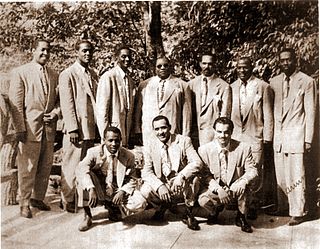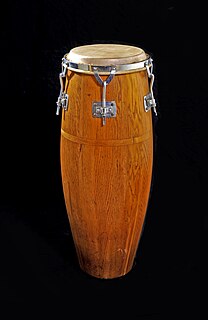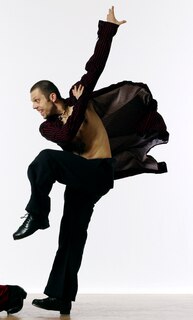
Salsa music is a popular dance music genre that initially arose in New York City during the 1960s. Salsa is the product of various Cuban musical genres including the Afro-Cuban son montuno, guaracha, cha cha chá, mambo, and Puerto Rican plena and bomba. Latin jazz has had a significant influence on salsa arrangers, piano guajeos, and instrumental soloists.
The term rumba may refer to a variety of unrelated music styles. Originally, "rumba" was used as a synonym for "party" in northern Cuba, and by the late 19th century it was used to denote the complex of secular music styles known as Cuban rumba. Since the early 20th century the term has been used in different countries to refer to distinct styles of music and dance, most of which are only tangentially related to the original Cuban rumba, if at all. The vague etymological origin of the term rumba, as well as its interchangeable use with guaracha in settings such as bufo theatre, is largely responsible for such worldwide polysemy of the term. In addition, "rumba" was the primary marketing term for Cuban music in North America, as well as West and Central Africa, during much of the 20th century, before the rise of mambo, pachanga and salsa.
A hand drum is any type of drum that is typically played with the bare hand rather than a stick, mallet, hammer, or other type of beater.

Arsenio Rodríguez was a Cuban musician, composer and bandleader. He played the tres, as well as the tumbadora, and he specialized in son, rumba and other Afro-Cuban music styles. In the 1940s and 1950s Rodríguez established the conjunto format and contributed to the development the son montuno, the basic template of modern-day salsa. He claimed to be the true creator of the mambo and was an important as well as a prolific composer who wrote nearly two hundred songs.

The conga, also known as tumbadora, is a tall, narrow, single-headed drum from Cuba. Congas are staved like barrels and classified into three types: quinto, tres dos or tres golpes (middle), and tumba or salidor (lowest). Congas were originally used in Afro-Cuban music genres such as conga and rumba, where each drummer would play a single drum. Following numerous innovations in conga drumming and construction during the mid-20th century, as well as its internationalization, it became increasingly common for drummers to play two or three drums. Congas have become a popular instrument in many forms of Latin music such as son, descarga, Afro-Cuban jazz, salsa, songo, merengue and Latin rock.

Ramón "Mongo" Santamaría Rodríguez was a Cuban percussionist and bandleader who spent most of his career in the United States. Primarily a conga drummer, Santamaría was a leading figure in the pachanga and boogaloo dance crazes of the 1960s. His biggest hit was his rendition of Herbie Hancock's "Watermelon Man", which was inducted into the Grammy Hall of Fame in 1998. From the 1970s, he recorded mainly salsa and Latin jazz, before retiring in the late 1990s.
Los Muñequitos de Matanzas is a Cuban rumba ensemble from the city of Matanzas. The group was established in 1952 as Conjunto Guaguancó Matancero and released their first LP in 1956 through Puchito. Since then, Los Muñequitos have continued to perform and record, becoming one of the most successful and critically acclaimed rumba groups of all time.
Guaguancó is a subgenre of Cuban rumba, combining percussion, voices, and dance. There are two main styles: Havana and Matanzas.
The term Latin percussion refers to any number of a large family of musical instruments in the percussion, membranophone, lamellophone and/or idiophone family used in Latin music, which in turn is a very loosely related group of musical styles, mainly from the Latin American region, and ultimately having roots or influences in African music.
Songo is a genre of popular Cuban music, created by the group Los Van Van in the early 1970s. Songo incorporated rhythmic elements from folkloric rumba into popular dance music, and was a significant departure from the son montuno/mambo-based structure which had dominated popular music in Cuba since the 1940s. Blas Egües was the first drummer in Los Van Van, but it was the band's second drummer, José Luis Quintana "Changuito", who developed songo into the world-wide phenomenon it is today.
Arará people are an Afro-Cuban ethnoreligious group descendant from the Dahomey kingdom of West Africa, and retain a separate identity, religion, and culture than other Afro-Cuban people. Although Arará people have historically staunchly retained a separate identity and religion, over time, this identity has become more blurred and harder to retain, but still exists.
Francisco Aguabella was an Afro-Cuban percussionist whose career spanned folk, jazz, and dance bands. He was a prolific session musician and recorded seven albums as a leader.
Rumba is a secular genre of Cuban music involving dance, percussion, and song. It originated in the northern regions of Cuba, mainly in urban Havana and Matanzas, during the late 19th century. It is based on African music and dance traditions, namely Abakuá and yuka, as well as the Spanish-based coros de clave. According to Argeliers León, rumba is one of the major "genre complexes" of Cuban music, and the term rumba complex is now commonly used by musicologists. This complex encompasses the three traditional forms of rumba, as well as their contemporary derivatives and other minor styles.

Makuta drums are tall cylindrical or barrel-shaped Afro-Cuban drums, often cited as an important influence on the development of the tumbadora or conga drum. They are used in sacred dance-drumming ceremonies associated with the descendants of slaves brought to Cuba from Central Africa. The word makuta is also used to refer to the dancing and rhythms associated with these drums.

The quinto is the smallest and highest pitched type of conga drum. It is used as the lead drum in Cuban rumba styles such as guaguancó, yambú, columbia and guarapachangueo, and it is also present in congas de comparsa. Quinto phrases are played in both triple-pulse and duple-pulse structures. In columbia, triple pulse is the primary structure and duple pulse is secondary. In yambú and guaguancó duple-pulse is primary and triple-pulse is secondary.

Max Pollak is percussive dancer and World Music expert. He was born in Vienna, Austria and became known for his work in percussive dance, World Music, tap dance, and choreography. He created "RumbaTap", which merged American Rhythm Tap with Afro-Cuban music and dance. He is the only non-Cuban member of the Afro-Cuban Rumba and folklore ensemble Los Muñequitos de Matanzas.
Alberto Zayas Govín was a Cuban rumba singer and songwriter who founded one of the first recorded rumba ensembles, Grupo Afrocubano Lulú Yonkori. He is considered one of the most important guaguancó vocalists/composers in the history of rumba.
Music of African heritage in Cuba derives from the musical traditions of the many ethnic groups from different parts of West Africa that were brought to Cuba as slaves between the 16th and 19th centuries. Members of some of these groups formed their own ethnic associations or cabildos, in which cultural traditions were conserved, including musical ones.

Pedrito Martinez is a Cuban percussionist, drummer, singer, dancer, bandleader, songwriter, composer, and educator. He was born and raised in Havana, Cuba. He is a Cuban Conguero performing classic Cuban Rumbas, Afro-Cuban folkloric and religious music. He is a Santería priest. He came to the United States of America from Havana in 1998. He plays the Batá drum, conga, cajón, timbale, and bongo drums, among other percussion instruments. Pedrito learned his craft from the streets of Havana, Cuba. He has performed with Paquito D’Rivera, Arturo O’Farrill, Brian Lynch, and Bruce Springsteen. He settled in the New York City - New Jersey area in 1998.








